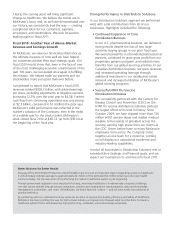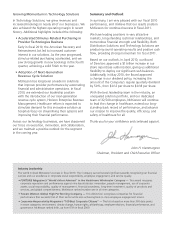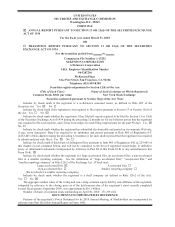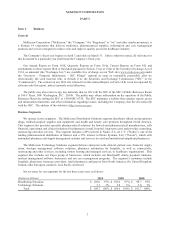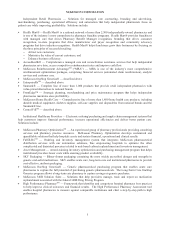McKesson 2010 Annual Report Download - page 13
Download and view the complete annual report
Please find page 13 of the 2010 McKesson annual report below. You can navigate through the pages in the report by either clicking on the pages listed below, or by using the keyword search tool below to find specific information within the annual report.McKESSON CORPORATION
7
The product portfolio for the Technology Solutions segment is designed to address a wide array of healthcare
clinical and business performance needs ranging from medication safety and information access to revenue cycle
management, resource utilization and physician adoption of electronic health records (“EHR”). Analytics software
enables organizations to measure progress as they automate care processes for optimal clinical outcomes, business
and operating results and regulatory compliance. To ensure that organizations achieve the maximum value for their
information technology investment, we also offer a wide range of services to support the implementation and use of
solutions as well as assist with business and clinical redesign, process re-engineering and staffing (both information
technology and back-office).
Key solution areas are as follows:
Clinical management: Horizon Clinicals® is built with architecture to facilitate integration and enable modular
system deployment. The solution suite includes a clinical data repository, health care planning, physician order
entry, point-of-care documentation with bar-coded medication administration, enterprise laboratory, radiology,
pharmacy, surgical management, an emergency department solution and an ambulatory EHR system. Horizon
Clinicals® also includes solutions to facilitate physician access to patient information such as a Web-based
physician portal and wireless devices that draw on information from the hospital’s information systems. In addition,
the Horizon Clinicals® suite includes a comprehensive solution for homecare, including telehealth and hospice.
Enterprise imaging: In addition to document imaging to facilitate maintenance and access to complete medical
records, we offer medical imaging and information management systems for healthcare enterprises, including a
picture archiving communications system, a radiology information system and a comprehensive cardiovascular
information system. Our enterprise-wide approach to medical imaging enables organizations to take advantage of
specialty-specific workstations while building an integrated image repository that manages all of the images and
information captured throughout the care continuum.
Financial management: Revenue management solutions are designed to improve financial performance by
reducing days in accounts receivable, preventing insurance claim denials, reducing costs and improving
productivity. Solutions include online patient billing, contract management, electronic claims processing and coding
compliance checking. Horizon Enterprise Revenue ManagementTM streamlines patient access and helps
organizations to forecast financial responsibility for all constituents before and during care. The system also
streamlines financial processes to allow providers to collect their reimbursement more quickly and at a lower cost.
Hospital information systems play a key role in managing the revenue cycle by automating the operation of
individual departments and their respective functions within the inpatient environment.
Resource management: Resource management solutions are designed to enhance an organization’s ability to
plan and optimize quality care delivery. Enterprise visibility and performance analytics provide business
intelligence that enables providers to manage capacity, outcomes, productivity and patient flow. Workforce
management solutions assist caregivers with staffing and maintaining labor rule continuity between scheduling, time
and attendance and payroll. A comprehensive supply chain management solution integrates enterprise resource
planning applications, including financials, materials, Human Resources/Payroll, with scheduling, point of use,
surgical services and enterprise-wide analytics.
Automation: Automation solutions include technologies that help hospitals re-engineer and improve their
medication use processes. Examples include centralized pharmacy automation for dispensing unit-dose
medications, unit-based cabinet technologies for secure medication storage and rapid retrieval and an anesthesia cart
for dispensing of medications in the operating room. Based on a foundation of bar-code scanning technology, these
integrated solutions are designed to reduce errors and bring new levels of safety to patients.



